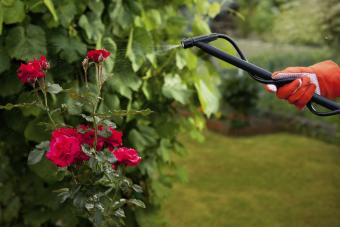
You can learn how to get rid of powdery mildew that can infect all kinds of plants. This fungal disease weakens plants, inhibiting their growth and blooming capacity.
How to Detect Powdery Mildew
The first signs of powdery mildew are small round powder-like spots that show up on the plant stems and leaves. These powder-like spots may go unnoticed if you have no experience with this disease. As the disease advances, the mildew will spread over the top part of the leaves, and sometimes the undersides.
Effect of Powdery Mildew on Leaves, Plants, Vegetables, and Fruits
Plants suffering from powdery mildew are evident when the leaves become contorted and twisted. These malformations are a telltale sign of their struggle to receive nutrients as the leaves become dehydrated. The mildew coats the leaves and effectively blocks them from absorbing the necessary sunlight for the photosynthesis process. Without vital nutrients, the leaves begin to turn yellow. If untreated, the fungal infection will eventually kill your plants.

How to Get Rid of Powdery Mildew From Plants
The first thing you need to do is get control of your garden. You need to gather a few gardening basics.
Supplies
- 1 pair of gardening scissors/shears
- 1 plastic garbage bag (or bag for yard waste, depending on your landfill requirements)
- 1 pair of disposable gloves
- A fungicide or homemade fungicide spray (see below)
Instructions
- You want to cut away all infected areas of the plant.
- Place discarded stem, fruits, buds, and leaves in the garbage bag.
- Don't place the cut portions onto your compost pile since they will contaminate everything they come into contact with.
- Place your gloves into the garbage bag, seal it and place it in the designated spot for pick up.
- Once you've finished pruning and disposing of the infected plant parts, you'll need to spray the scissors with the fungicide or your homemade spray to prevent reinfecting the plants or infecting other plants.
Spray Plants With Fungicide
The only way to effectively get rid of powdery mildew is to spray a fungicide on the infected plants. You can find organic fungicides created specifically for powdery mildew. Follow the manufacturer's instruction on the bottle of fungicide.
Create Your Own Fungicide
You can also create your own fungicide spray with a few common ingredients. You'll need a gallon garden sprayer.
- 1 tablespoon of sodium bicarbonate (baking soda)
- 1 teaspoon of liquid soap, non-detergent
- 1 gallon of water
Instructions for Your Own Fungicide
- Mix ingredients well by shaking the sprayer.
- Spray mixture onto infected plants.
- The soap will assist the solution in adhering to the plants.

Maintenance and Prevention
Once you've completed treating your plants with the fungicide, you want to keep a close watch over them to ensure the fungus doesn't return.
What Causes Powdery Mildew and How to Prevent It
Like most fungal diseases, powdery mildew thrives in wet, warm, highly humid environments. There are a few things you can do to lessen the odds of your plants contracting powdery mildew.
- Keep your plant prune to avoid overcrowding conditions and stopping air flow around plants.
- Remove low lying leaves and limbs so they don't come in contact with the soil or splashing water.
- Always water plants from the ground below the first leaves, close to the main stalk/stem and never overhead in a spray.
- Turn the water on low flow and don't spray. Splashing water onto plants sets up conditions for powdery mildew to move in.
Knowing How to Get Rid of Powdery Mildew From Plants
When you understand how to get rid of powdery mildew, you can regain control of your garden and save your plants. Taking preventative steps is the best way to avoid this plant fungal infection as well as plant molds.







